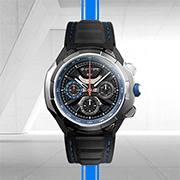Chassis No. 718-023 Engine No. 90215 Transmission No. 718101 Porsche’s first true post-war racing car, the 550 Spyder, was described by Christophorus, Porsche’s factory publication, rather dryly upon debut. “Unlike the normal Porsche arrangement, in the Spyder the engine is mounted in front of the back axle while the gearbox is placed behind the axle. The engine is easily accessible, since the whole of the tail can be hinged upwards.” Porsche went on to discuss the fuel tank capacity (65 or 90 liters), spare wheel location (at the rear), and maximum speed for the 1.5-liter Carrera four-cam engine (7,000 rpm). What Porsche failed to capture was that the light, lithe aluminum bodied sports racer would be an instant hit, catapulting Porsche to their first overall World Sportscar Championship race win (the 1956 Targa Florio) and a near-countless haul of class wins for the factory and privateers alike in Europe, North and South America, and even Africa. What was officially known as the 550 Spyder became the “Giant Killer,” setting the template for future designs, the structure of the Porsche System Engineering factory race team, and the customer racing department. Over the winter of 1958 and into 1959, Porsche would develop their latest Giant Killer, the Porsche 718 RSK Spyder. The new four-cam powered Spyder represented a major leap forward—lighter, faster, and more technically sophisticated than anything Porsche had previously fielded. The 718 featured a newly designed space frame, welded from extruded steel tubes, that was both lighter and stronger. The bodywork by Wendler Karosserie of Reutlingen was lowered to reduce aerodynamic drag, and its front profile was dramatically smoothed mirroring that of the Type 645 “Mickeymaus” prototype. A smooth, uninterrupted body surface with no large air intakes enhanced airflow. A unique detail of the design was the integration of engine oil lines through the front hood, allowing the panel itself to serve as a secondary cooling device. The 718 RSK featured louvered panels and “Turbofin” vanes directing air to large drum brakes, while its bodywork evolved with vertical tail fins and faired-over passenger seat for long endurance races. Weighing under 530 kilograms, it introduced major suspension changes, including coil springs and telescopic dampers replacing the rear torsion bars. A mid-mounted steering wheel and symmetrical track rods hinted at Formula Two potential. Its refined four-cam flat-four engine produced up to 148 horsepower, paired with a five-speed gearbox, delivering standout performance on world-class circuits. Over the 1958 and 1959 race seasons, the 718 RSK—with its renowned Fuhrmann four-cam engine—proved itself across nearly every level of international motorsport. It was a consistent front-runner, earning podiums and outright wins in long-distance endurance events, sprint races, punishing hill climbs, true road courses like the Targa Florio, and even Formula Two competition thanks to a center-seat layout. Its success reflects Porsche’s characteristic focus on thoughtful engineering to be a “jack of all trades” with a longer evolution and built-in reliability. After building seven in-house “werks” cars for its factory team in 1958, Porsche began producing customer RSK Spyders late that year. Customer cars began with chassis number 718-011 and debuted in January 1959. Just 24 examples were built over the next seven months, headed to privateers around the globe looking to emulate the factory’s success. Chassis number 718-023 was one of those rare 24 customer cars. Porsche Carrera Four-Cam by Sprenger and Heinrichs lists the build specification. With its bodywork finished at Wendler, chassis number 023 completed production at Porsche’s Werks 1 race department in March 1959 in Silver Metallic over a Red upholstered interior. Factory notes record the car was destined to be delivered to the French Sonauto distributor before it landed in the United States with Roy Schechter of Miami, Florida. Schechter was a New Yorker who earned his wings after enlisting in the United States Army Air Corps in 1944. Flying the B-24, he completed over 50 combat missions and later flew P-38 and P-47 fighters from North Africa receiving the Distinguished Flying Cross and Air Medal for his virtuous efforts. Upon returning home, Schechter moved to Florida and began racing with the SCCA in a Mercedes-Benz 300 SL Gullwing. He quickly moved to more pure-bred racing machinery including a Lotus 11 and then, by 1958, a used Porsche 550 Spyder that would launch him into the next phase of his career. With Schechter at the wheel, Porsche 718 RSK chassis 023 was immediately successful. Entered as start number 7 in the Las Cuatro Horas de Alamar, a four-hour street circuit race in Cuba, Schechter finished 4th overall on debut. In October the RSK, now with start number 27, was entered in the SCCA’s Fifth Annual Sports Car Races at Courtland Airbase where Schechter won the main Ingram Trophy race and took a further second place in a full field that consisted of a Jaguar XKSS, Maserati 450S, and Ferrari 750 Monza. Later that month, again as number 27, the RSK was driven to podium places in all three weekend races at Napier Field in Alabama. In December, RSK 718-023 made the trek to the Bahamas for the Nassau Trophy Road Races as part of Bahamas Speed Week. The races at Oakes Field course in the late 1950s offered a sun-soaked atmosphere for not only American competitors but many of the finest European drivers and teams already weary of the impending winter. As a result, Nassau became a who’s who of the world’s best drivers with names like Moss, Gurney, Shelby, Hill, Brabham, Rodriguez, Bonnier, and Salvadori with Schechter and the RSK included! The Spyder was entered in the F class races and that group included Ken Miles, Harry Blanchard, Johnny Cuevas, Jim Rathman, and Bob Holbert. Quite the group! Over four races that week, the car, again as start number 27, finished every race with a best of 5th in the Governor’s Trophy and an incredible 3rd place podium finish in the all-Porsche Race behind Harry Blanchard and Count Wolfgang von Trips! Quite the finish for a very successful 1959 race season. To start 1960, it is noted that Schechter entered 023 into the Gran Premio Libertad races in Cuba but did not attend. The car then took part in the first round of the SCCA National Sports Car Championship at Corry Field in Pensacola, Florida, that April. It was a successful weekend for Schechter finishing 4th overall and 2nd in class to Roger Penske in another RSK. Interestingly, Schechter’s successes with RSK Spyder 023 landed him a ride with Bob Holbert and his Brumos supported 718 RS 60 Spyder for the 1960 Sebring 12 Hours finishing second overall! By this point Schechter had become a Porsche dealer and, looking to add a Volkswagen franchise to bolster sales, decided to concentrate on his expanding business and sold 718-023 to Tom Beil of Pennsylvania. A September 1960 Road & Track advertisement describes the car listed for $8,500 as “hasn’t been run since major o/haul. Ready to go." According to the Riesentoter Region’s Porsche Club of America magazine Der Gasser, Beil was active in Pennsylvania hill climbs—one of the many diverse racing formats for which the RSK had been purpose-built. Records show that Beil diced with Jim Haas in a similar RSK setting class records in what became known as “battle of the RSKs." Next the RSK joined the growing Denver, Colorado, Porsche collection of Dr. William E. Jackson by the late 1960s. Dr. Jackson was an ophthalmologist obsessed with building one of the finest and most considered Porsche collections in the world. The 718 RSK Spyder fit nicely among the active Rocky Mountain PCA Region member’s collection that included some 50+ Porsches. Beginning with the purchase of his first in 1963, the collection expanded by the early 1970s to include a Gmünd Coupe, an America Roadster, Abarth Carrera, 904 Carrera GTS, a 911 R, the Sebring-winning 1973 Carrera RSR, and Carrera RSR 2.1 Turbo R9 among many others. Jackson kept the RSK in his downtown Denver warehouse for the better part of three decades before it was reportedly sold to Hervé Willems of Heritage Classics Motorcar Company of West Hollywood. RSK eventually 718-023 made its way into the hands of Florida-based collector E. Kent Rawson, where it joined a carefully curated assemblage of early Porsche sports and racing cars. In 2006, following a meticulous restoration carried out to concours standards, the car was acquired by Peter Wirichs, a dedicated Porsche enthusiast based in Germany. In January 2008, the RSK was subjected to a detailed evaluation by none other than Jürgen Barth—veteran racer and one of the foremost authorities on Porsche history. Barth's report, a copy of which is on file, provides the original build information on the car from none other Hubert Mimler. Furthermore, it recounts the ownership chain as it was known until that point. RSK Spyder 718-023 then returned to the United States joining a distinguished New York collection, having been acquired after a lengthy and selective search for a top-tier four-cam Spyder. While with this owner, the RSK was serviced at Paul Russell and Company ensuring it remained in impeccable mechanical and visual condition. In 2013, the car was sold publicly and later appeared back in Europe on the stand at both the 2015 editions of Rétromobile and Techo-Classica Essen. In 2021, chassis 023 joined the current caretaker’s Southern California-based collection noted for its eclectic mix spanning pre-war luxury to modern day hypercars. Incredibly the RSK retains its numbers matching Fuhrmann four-cam engine (serial number 90215) to this day. It should be noted that while the car has become a fixture on Southern California roads, it was also selected to participate in the 2022 European Grand Tour, a multi-country European drive organized by Road Scholars. In advance of the overseas trip, RSK Spyder 023 received the fastidious mechanical preparation Road Scholars of Durham, North Carolina, is well-known for, and the car was noted to perform quite admirably. Porsche 718 RSK Spyder 023 is a rare example of a Porsche purpose-built to win and still ready to be driven in that spirit today. As one of just 24 customer RSK Spyders constructed and one of only 13 delivered to the United States, it offers more than just a stunning aesthetic; it represents a pure expression of Porsche’s four-cam engineering at its peak. With documented success in period SCCA racing, the Speed Week in Nassau, and kept within the best hands while under private ownership, its history is as compelling as its design. But this is no static artifact. Carefully maintained and restored by expert hands and recently exercised across Europe and in Southern California, 718-023 has proven its continued vitality on road and track. Regarded by many as the most beautiful of the Porsche Spyder lineage, it remains a machine that rewards spirited driving as much as quiet admiration—an ideal entrant for premier vintage rallies, and a definitive example of why the RSK remains one of Porsche’s most celebrated competition cars. Please note Online Bidding is not available for this lot. For further information and alternative bidding options please reach out to bid@broadarrowauctions.com
- Fuel
- Body Types
- Transmission
- Exterior Colour
- Number of doors
- Interior Colour
- VIN Code718023















































































































































































































